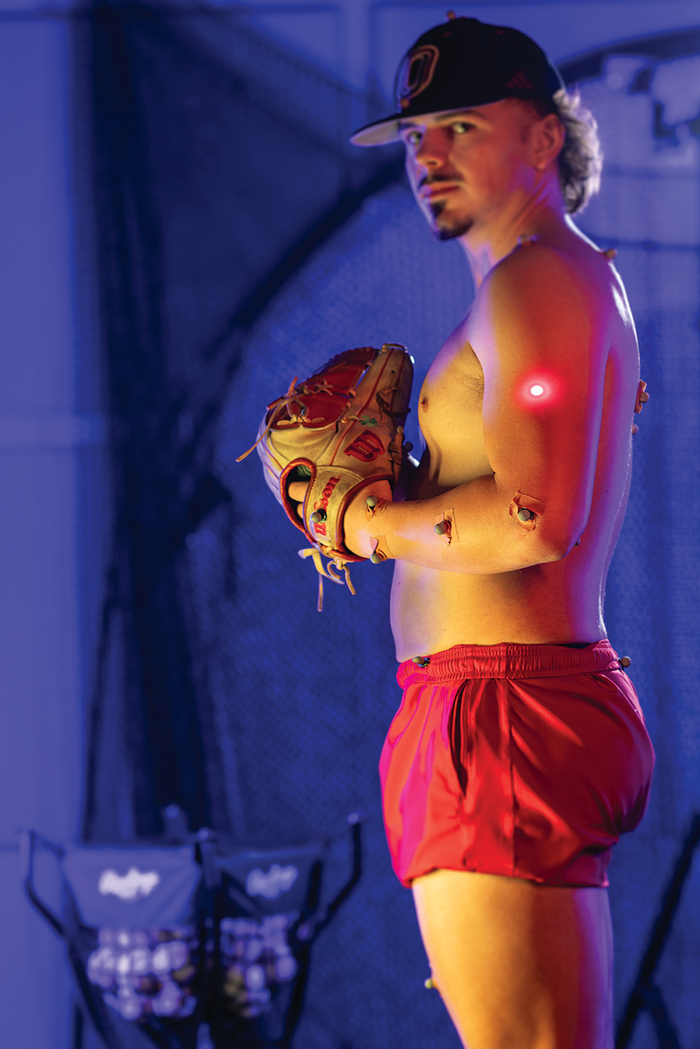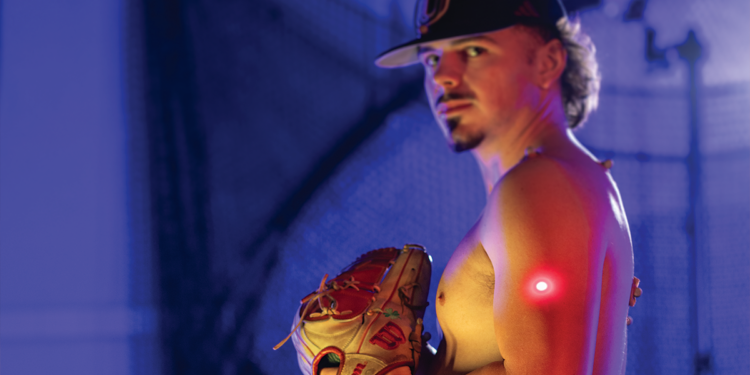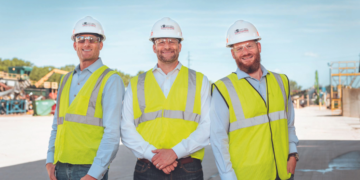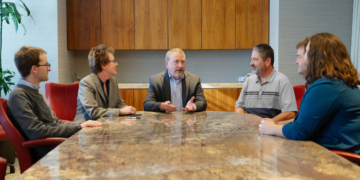“You want your body to be moving very smoothly and in sync,” explained Dr. Brian Knarr, Co-director of University of Nebraska Omaha’s Biomechanics Pitching Lab. “When it’s out of sync, that’s usually when you have injuries or pain, and it’s where you leave energy on the table. You want all of that energy you’re generating to go into the ball. If you’re moving inefficiently, that energy gets lost by having to catch up or move in incorrect ways.”
Fortunately for athletes all over the country, UNO’s Sports Medicine and Biomechanics Lab is equipped to evaluate both clinical and performance data to protect an athlete from injury while helping them reach for the next goal. Currently, only a handful of similar labs can be found in research universities across the US.
“I looked at everything in the US, but this pitching lab is my big reason for being here,” said Takato Ogasawara, a student in UNO’s Biomechanics master’s program, who performs analyses on the lab’s clients. “I was working as an athletics trainer, but I felt like I needed to understand more of the ‘why.’ Like, for example, in baseball, if I look at just the body without the pitching, I’m only seeing how things are outside the movement. In the pitching lab, I can know which muscle they’re specifically using or what is the range of motion within the movement. You can sort of see it [without these tools], but it’s hard.”
Think of the behind-the-scenes footage you’ve seen of all those superhero movies—specifically, the actor wearing what looks like a bunch of shiny little ping-pong balls. “That is the exact same technology that’s used in biomechanics historically,” Dr. Knarr said. “Those allow us to reconstruct someone’s skeleton in software.”
A typical evaluation takes about two hours. After a clinical analysis of an athlete’s strength range, motion flexibility, and overall joint health, a biomechanist—or, say, a biomechanist student like Ogasawara—places retro-reflective markers on the athlete’s body, indicating where certain anatomical features are and where specific parts of the body would be in space as the athlete moves around the lab.
“We analyze the actual pitching movement,” Ogasawara explained, “measuring things like how fast they move and how much stress they put on their elbow, their shoulder—that kind of stuff.”
The lab’s custom pitching mound is encircled by 20 cameras (around $10,000 apiece) and is composed of three six-degrees-of-freedom force plates ($20,000 apiece) that record all the ways an athlete imparts force onto the mound. The motion capture data and the force plate data are fed into a program such as Visual3D, which creates a model of the athlete for analysis.
“Ideally, about a week post-evaluation, the athlete meets one-on-one with our lead biomechanist,” explained Dr. Adam Rosen, co-director of the lab with Dr. Knarr. “He will sit with them for about an hour and go through the data with them rather than just sending the report.”
“Historically, other places that have implemented this type of system take all that data, dump it on a spreadsheet, and say, ‘Here you go,’” Dr. Knarr said. “No one knows what to do with that data, because you’re giving non-biomechanists and non-athletic trainers biomechanist data. So, we do all the distilling, and we say, ‘Here are the two things we think you should address first, because these are probably the biggest things you have to fix before anything else can get fixed.’ And we give them drills or suggestions on how to do that.”
While UNO’s Biomechanics Lab does, of course, serve UNO’s athletes, its clients are mostly private individuals. “We’ve seen everyone from 8-year-olds all the way to professional pitchers,” Dr. Rosen said. The lab’s most common client, however, is probably the aspiring professional—someone who wants to be seen and wants to get drafted. “The number one reason people come to us is ‘I want to throw faster.’ How do they increase their spin rate, get more movement on their fast ball?”
The next major endeavor for the lab is to expand more into servicing women’s athletics. “The last year or so, we’ve made a lot of acceleration on softball pitching,” Dr. Knarr explained. “We’ve partnered with OGX [a company that advances softball development through individualized, science-backed programs] to develop the same level and fidelity of pitching analysis in softball as we have in baseball, which currently doesn’t exist at all.”
Is analyzing a softball player so different from analyzing a baseball player?
“It is literally 180 degrees different, which has historically been the problem,” Dr. Knarr said with enthusiasm. “A lot of people think they can translate the biomechanics of baseball pitching, an overhead-throwing motion, to softball pitching, which is an underhand-throwing motion. They are fundamentally entirely different.”
The historical neglect of softball, not to mention other women’s sports, in research and technology can to some extent be blamed on lesser profitability in the market, but fortunately, as Dr. Knarr said, “This is the academic side of it, right? Running this as an academic endeavor and not like a business endeavor, we can focus on where we can help people the best.”
For more information about UNO’s Pitching Lab or to book a consultation, visit unomaha.edu/college-of-education-health-and-human-sciences/sports-medicine-and-biomechanics.

This article originally appeared in the March/April 2024 issue of Omaha Magazine. To subscribe, click here.

Photo by Bill Sitzmann.
“You want your body to be moving very smoothly and in sync,” explained Dr. Brian Knarr, Co-director of University of Nebraska Omaha’s Biomechanics Pitching Lab. “When it’s out of sync, that’s usually when you have injuries or pain, and it’s where you leave energy on the table. You want all of that energy you’re generating to go into the ball. If you’re moving inefficiently, that energy gets lost by having to catch up or move in incorrect ways.”
Fortunately for athletes all over the country, UNO’s Sports Medicine and Biomechanics Lab is equipped to evaluate both clinical and performance data to protect an athlete from injury while helping them reach for the next goal. Currently, only a handful of similar labs can be found in research universities across the US.
“I looked at everything in the US, but this pitching lab is my big reason for being here,” said Takato Ogasawara, a student in UNO’s Biomechanics master’s program, who performs analyses on the lab’s clients. “I was working as an athletics trainer, but I felt like I needed to understand more of the ‘why.’ Like, for example, in baseball, if I look at just the body without the pitching, I’m only seeing how things are outside the movement. In the pitching lab, I can know which muscle they’re specifically using or what is the range of motion within the movement. You can sort of see it [without these tools], but it’s hard.”
Think of the behind-the-scenes footage you’ve seen of all those superhero movies—specifically, the actor wearing what looks like a bunch of shiny little ping-pong balls. “That is the exact same technology that’s used in biomechanics historically,” Dr. Knarr said. “Those allow us to reconstruct someone’s skeleton in software.”
A typical evaluation takes about two hours. After a clinical analysis of an athlete’s strength range, motion flexibility, and overall joint health, a biomechanist—or, say, a biomechanist student like Ogasawara—places retro-reflective markers on the athlete’s body, indicating where certain anatomical features are and where specific parts of the body would be in space as the athlete moves around the lab.
“We analyze the actual pitching movement,” Ogasawara explained, “measuring things like how fast they move and how much stress they put on their elbow, their shoulder—that kind of stuff.”
The lab’s custom pitching mound is encircled by 20 cameras (around $10,000 apiece) and is composed of three six-degrees-of-freedom force plates ($20,000 apiece) that record all the ways an athlete imparts force onto the mound. The motion capture data and the force plate data are fed into a program such as Visual3D, which creates a model of the athlete for analysis.
“Ideally, about a week post-evaluation, the athlete meets one-on-one with our lead biomechanist,” explained Dr. Adam Rosen, co-director of the lab with Dr. Knarr. “He will sit with them for about an hour and go through the data with them rather than just sending the report.”
“Historically, other places that have implemented this type of system take all that data, dump it on a spreadsheet, and say, ‘Here you go,’” Dr. Knarr said. “No one knows what to do with that data, because you’re giving non-biomechanists and non-athletic trainers biomechanist data. So, we do all the distilling, and we say, ‘Here are the two things we think you should address first, because these are probably the biggest things you have to fix before anything else can get fixed.’ And we give them drills or suggestions on how to do that.”
While UNO’s Biomechanics Lab does, of course, serve UNO’s athletes, its clients are mostly private individuals. “We’ve seen everyone from 8-year-olds all the way to professional pitchers,” Dr. Rosen said. The lab’s most common client, however, is probably the aspiring professional—someone who wants to be seen and wants to get drafted. “The number one reason people come to us is ‘I want to throw faster.’ How do they increase their spin rate, get more movement on their fast ball?”
The next major endeavor for the lab is to expand more into servicing women’s athletics. “The last year or so, we’ve made a lot of acceleration on softball pitching,” Dr. Knarr explained. “We’ve partnered with OGX [a company that advances softball development through individualized, science-backed programs] to develop the same level and fidelity of pitching analysis in softball as we have in baseball, which currently doesn’t exist at all.”
Is analyzing a softball player so different from analyzing a baseball player?
“It is literally 180 degrees different, which has historically been the problem,” Dr. Knarr said with enthusiasm. “A lot of people think they can translate the biomechanics of baseball pitching, an overhead-throwing motion, to softball pitching, which is an underhand-throwing motion. They are fundamentally entirely different.”
The historical neglect of softball, not to mention other women’s sports, in research and technology can to some extent be blamed on lesser profitability in the market, but fortunately, as Dr. Knarr said, “This is the academic side of it, right? Running this as an academic endeavor and not like a business endeavor, we can focus on where we can help people the best.”
For more information about UNO’s Pitching Lab or to book a consultation, visit unomaha.edu/college-of-education-health-and-human-sciences/sports-medicine-and-biomechanics.

This article originally appeared in the March/April 2024 issue of Omaha Magazine. To subscribe, click here.

Photo by Bill Sitzmann.
“You want your body to be moving very smoothly and in sync,” explained Dr. Brian Knarr, Co-director of University of Nebraska Omaha’s Biomechanics Pitching Lab. “When it’s out of sync, that’s usually when you have injuries or pain, and it’s where you leave energy on the table. You want all of that energy you’re generating to go into the ball. If you’re moving inefficiently, that energy gets lost by having to catch up or move in incorrect ways.”
Fortunately for athletes all over the country, UNO’s Sports Medicine and Biomechanics Lab is equipped to evaluate both clinical and performance data to protect an athlete from injury while helping them reach for the next goal. Currently, only a handful of similar labs can be found in research universities across the US.
“I looked at everything in the US, but this pitching lab is my big reason for being here,” said Takato Ogasawara, a student in UNO’s Biomechanics master’s program, who performs analyses on the lab’s clients. “I was working as an athletics trainer, but I felt like I needed to understand more of the ‘why.’ Like, for example, in baseball, if I look at just the body without the pitching, I’m only seeing how things are outside the movement. In the pitching lab, I can know which muscle they’re specifically using or what is the range of motion within the movement. You can sort of see it [without these tools], but it’s hard.”
Think of the behind-the-scenes footage you’ve seen of all those superhero movies—specifically, the actor wearing what looks like a bunch of shiny little ping-pong balls. “That is the exact same technology that’s used in biomechanics historically,” Dr. Knarr said. “Those allow us to reconstruct someone’s skeleton in software.”
A typical evaluation takes about two hours. After a clinical analysis of an athlete’s strength range, motion flexibility, and overall joint health, a biomechanist—or, say, a biomechanist student like Ogasawara—places retro-reflective markers on the athlete’s body, indicating where certain anatomical features are and where specific parts of the body would be in space as the athlete moves around the lab.
“We analyze the actual pitching movement,” Ogasawara explained, “measuring things like how fast they move and how much stress they put on their elbow, their shoulder—that kind of stuff.”
The lab’s custom pitching mound is encircled by 20 cameras (around $10,000 apiece) and is composed of three six-degrees-of-freedom force plates ($20,000 apiece) that record all the ways an athlete imparts force onto the mound. The motion capture data and the force plate data are fed into a program such as Visual3D, which creates a model of the athlete for analysis.
“Ideally, about a week post-evaluation, the athlete meets one-on-one with our lead biomechanist,” explained Dr. Adam Rosen, co-director of the lab with Dr. Knarr. “He will sit with them for about an hour and go through the data with them rather than just sending the report.”
“Historically, other places that have implemented this type of system take all that data, dump it on a spreadsheet, and say, ‘Here you go,’” Dr. Knarr said. “No one knows what to do with that data, because you’re giving non-biomechanists and non-athletic trainers biomechanist data. So, we do all the distilling, and we say, ‘Here are the two things we think you should address first, because these are probably the biggest things you have to fix before anything else can get fixed.’ And we give them drills or suggestions on how to do that.”
While UNO’s Biomechanics Lab does, of course, serve UNO’s athletes, its clients are mostly private individuals. “We’ve seen everyone from 8-year-olds all the way to professional pitchers,” Dr. Rosen said. The lab’s most common client, however, is probably the aspiring professional—someone who wants to be seen and wants to get drafted. “The number one reason people come to us is ‘I want to throw faster.’ How do they increase their spin rate, get more movement on their fast ball?”
The next major endeavor for the lab is to expand more into servicing women’s athletics. “The last year or so, we’ve made a lot of acceleration on softball pitching,” Dr. Knarr explained. “We’ve partnered with OGX [a company that advances softball development through individualized, science-backed programs] to develop the same level and fidelity of pitching analysis in softball as we have in baseball, which currently doesn’t exist at all.”
Is analyzing a softball player so different from analyzing a baseball player?
“It is literally 180 degrees different, which has historically been the problem,” Dr. Knarr said with enthusiasm. “A lot of people think they can translate the biomechanics of baseball pitching, an overhead-throwing motion, to softball pitching, which is an underhand-throwing motion. They are fundamentally entirely different.”
The historical neglect of softball, not to mention other women’s sports, in research and technology can to some extent be blamed on lesser profitability in the market, but fortunately, as Dr. Knarr said, “This is the academic side of it, right? Running this as an academic endeavor and not like a business endeavor, we can focus on where we can help people the best.”
For more information about UNO’s Pitching Lab or to book a consultation, visit unomaha.edu/college-of-education-health-and-human-sciences/sports-medicine-and-biomechanics.

This article originally appeared in the March/April 2024 issue of Omaha Magazine. To subscribe, click here.

Photo by Bill Sitzmann.
“You want your body to be moving very smoothly and in sync,” explained Dr. Brian Knarr, Co-director of University of Nebraska Omaha’s Biomechanics Pitching Lab. “When it’s out of sync, that’s usually when you have injuries or pain, and it’s where you leave energy on the table. You want all of that energy you’re generating to go into the ball. If you’re moving inefficiently, that energy gets lost by having to catch up or move in incorrect ways.”
Fortunately for athletes all over the country, UNO’s Sports Medicine and Biomechanics Lab is equipped to evaluate both clinical and performance data to protect an athlete from injury while helping them reach for the next goal. Currently, only a handful of similar labs can be found in research universities across the US.
“I looked at everything in the US, but this pitching lab is my big reason for being here,” said Takato Ogasawara, a student in UNO’s Biomechanics master’s program, who performs analyses on the lab’s clients. “I was working as an athletics trainer, but I felt like I needed to understand more of the ‘why.’ Like, for example, in baseball, if I look at just the body without the pitching, I’m only seeing how things are outside the movement. In the pitching lab, I can know which muscle they’re specifically using or what is the range of motion within the movement. You can sort of see it [without these tools], but it’s hard.”
Think of the behind-the-scenes footage you’ve seen of all those superhero movies—specifically, the actor wearing what looks like a bunch of shiny little ping-pong balls. “That is the exact same technology that’s used in biomechanics historically,” Dr. Knarr said. “Those allow us to reconstruct someone’s skeleton in software.”
A typical evaluation takes about two hours. After a clinical analysis of an athlete’s strength range, motion flexibility, and overall joint health, a biomechanist—or, say, a biomechanist student like Ogasawara—places retro-reflective markers on the athlete’s body, indicating where certain anatomical features are and where specific parts of the body would be in space as the athlete moves around the lab.
“We analyze the actual pitching movement,” Ogasawara explained, “measuring things like how fast they move and how much stress they put on their elbow, their shoulder—that kind of stuff.”
The lab’s custom pitching mound is encircled by 20 cameras (around $10,000 apiece) and is composed of three six-degrees-of-freedom force plates ($20,000 apiece) that record all the ways an athlete imparts force onto the mound. The motion capture data and the force plate data are fed into a program such as Visual3D, which creates a model of the athlete for analysis.
“Ideally, about a week post-evaluation, the athlete meets one-on-one with our lead biomechanist,” explained Dr. Adam Rosen, co-director of the lab with Dr. Knarr. “He will sit with them for about an hour and go through the data with them rather than just sending the report.”
“Historically, other places that have implemented this type of system take all that data, dump it on a spreadsheet, and say, ‘Here you go,’” Dr. Knarr said. “No one knows what to do with that data, because you’re giving non-biomechanists and non-athletic trainers biomechanist data. So, we do all the distilling, and we say, ‘Here are the two things we think you should address first, because these are probably the biggest things you have to fix before anything else can get fixed.’ And we give them drills or suggestions on how to do that.”
While UNO’s Biomechanics Lab does, of course, serve UNO’s athletes, its clients are mostly private individuals. “We’ve seen everyone from 8-year-olds all the way to professional pitchers,” Dr. Rosen said. The lab’s most common client, however, is probably the aspiring professional—someone who wants to be seen and wants to get drafted. “The number one reason people come to us is ‘I want to throw faster.’ How do they increase their spin rate, get more movement on their fast ball?”
The next major endeavor for the lab is to expand more into servicing women’s athletics. “The last year or so, we’ve made a lot of acceleration on softball pitching,” Dr. Knarr explained. “We’ve partnered with OGX [a company that advances softball development through individualized, science-backed programs] to develop the same level and fidelity of pitching analysis in softball as we have in baseball, which currently doesn’t exist at all.”
Is analyzing a softball player so different from analyzing a baseball player?
“It is literally 180 degrees different, which has historically been the problem,” Dr. Knarr said with enthusiasm. “A lot of people think they can translate the biomechanics of baseball pitching, an overhead-throwing motion, to softball pitching, which is an underhand-throwing motion. They are fundamentally entirely different.”
The historical neglect of softball, not to mention other women’s sports, in research and technology can to some extent be blamed on lesser profitability in the market, but fortunately, as Dr. Knarr said, “This is the academic side of it, right? Running this as an academic endeavor and not like a business endeavor, we can focus on where we can help people the best.”
For more information about UNO’s Pitching Lab or to book a consultation, visit unomaha.edu/college-of-education-health-and-human-sciences/sports-medicine-and-biomechanics.

This article originally appeared in the March/April 2024 issue of Omaha Magazine. To subscribe, click here.

Photo by Bill Sitzmann.













